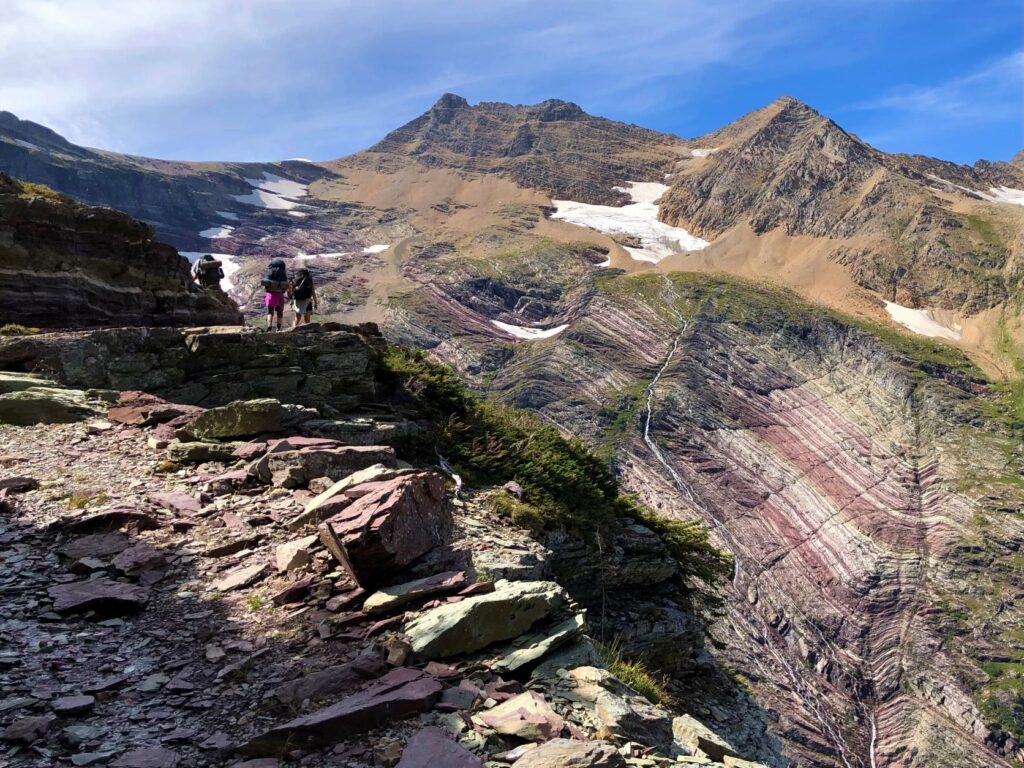By Olivia Dugenet
Tiny in the midst of the string of mountains and knife-edge peaks, a barely-visible ribbon of dirt trail meandered along a ridgeline. Three miniscule shapes moved along the track, slow beneath the weight of their heavy packs. Sounds of laughter and conversation faded into the wind and waterfalls.
A group of friends—all women and moms in or approaching middle age—climbed switchbacks toward a mountain pass far from any trailhead. We were the only all-women group of backpackers we encountered in three days. We saw a handful of couples and mixed groups of men and women, but most backcountry campers we met were men traveling together.
This is typical of every backpacking trip I take, and yet somehow I am still surprised at how uncommon it is to see groups of women, especially those 40 and older, unaccompanied by men in wild spaces. It says a lot about how our culture continues to view women in the outdoors.
So many youthful, vibrant women nearing the middle of their lives are already looking back and saying, “I wish I would have tried stuff like that when I was younger.” But we are younger, right now, than we will be later. What better time to go?
Olivia Dugenet
Maybe that’s why it didn’t occur to me at first to invite other women and moms on wilderness trips. I have been backpacking with my daughters every summer since they were six and eight years old, and I have never encountered another solo mom leading kids out on the trail.
I always felt like an outlier. I assumed, wrongly, of course, that women my age who aren’t already established in an outdoor activity or lifestyle are simply not into that kind of thing. I was surprised and really delighted when women I’ve known for many years started asking if they could join me.
My daughters have grown into adult-size teenagers with adult-size packs to lend. So, I started putting together additional trips to include women friends who had never had an opportunity to try backpacking.
Quite by accident, I found myself serving as an informal, volunteer backcountry guide with a patched-together gear library and a super nerdy zeal for planning and logistics. It’s a lot of work, and certainly worth the effort.
When we walk out of the wilderness after a beautiful, brutal multi-day trip, everyone is tired, dirty and hungry. I always wonder if my friends secretly hated the whole experience, especially those who struggled with self-doubt and discomfort along the way.
Instead, they consistently report a feeling of euphoria, even describing trips as “life-changing.” What is it about walking outside for a few days that generates such a profound visceral response?
Author Florence Williams explores the transformative effect that wilderness can have in her analysis of the “Three-Day Effect”—a scientifically-tested phenomenon in which people who spend multiple consecutive days in wild spaces without digital devices experience an astonishing 47% increase in creative thinking and insight problem solving.
Not everyone enjoys equal access to that wilderness euphoria. In 2016, REI published a blog post called “Closing the Gender Gap in the Great Outdoors.” Author Katherine Oakes cited research from the Outdoor Foundation finding that 66% of boys ages 6-24 participated in outdoor activities, compared with only 55% of girls in the same age group.

More interesting, however, is that as women age, their participation in outdoor activities drops off. By age 66, only 20% of women report engaging in outdoor activities compared with 40% of men. The Outdoor Foundation’s new 2021 report on outdoor trends still finds “stagnant female participation” despite “significant industry efforts to address gender disparities.”
It is not that women and moms don’t want to get out there. Many do, though I can see why some women stop participating in outdoor activities as they age.
Motherhood is demanding. We put a lot on hold while raising children, giving much of ourselves away to our kids, families and jobs without always finding ways to replenish.
Years pass quickly, we get into a routine, and soon it feels too late to start something new. So many youthful, vibrant women nearing the middle of their lives are already looking back and saying, “I wish I would have tried stuff like that when I was younger.” But we are younger, right now, than we will be later. What better time to go?
Cultural narratives over many generations have created a distorted social reality where women, especially as they age, are made to appear inept or disinterested in wilderness. These false stories may influence how women perceive themselves and their capacities.
At the same time, through all the noise and distraction of everyday life, there is this other wild reality, vivid, physical and very close by. Some joyful part of me is always there, caked in dirt and sweat on the blue lake shore, diving into the icy water and then rising up again into afternoon mountain sun.
It is true that women must be disproportionately brave to enter wilderness, but not because we are afflicted with some special type of female weakness that makes us too scared or incapable to navigate the outdoors. Women are brave to challenge stereotypes and social expectations that try to convince us we don’t belong at home in our own wild world.
Olivia Dugenet is a writer and nonprofit professional living in Spokane. She holds a Master of Science in Cultural Communication from EWU, and spends a lot of time thinking about philosophy of nature. Her best adventures are with her husband, four wonderful grown-up children and their Yellow Lab Zizou.
Originally published in the November-December 2021 print issue.
Find more personal essays in the Last Page column archives.
Read “Mountain Biking Women of Spokane” (March 2020 print issue).













